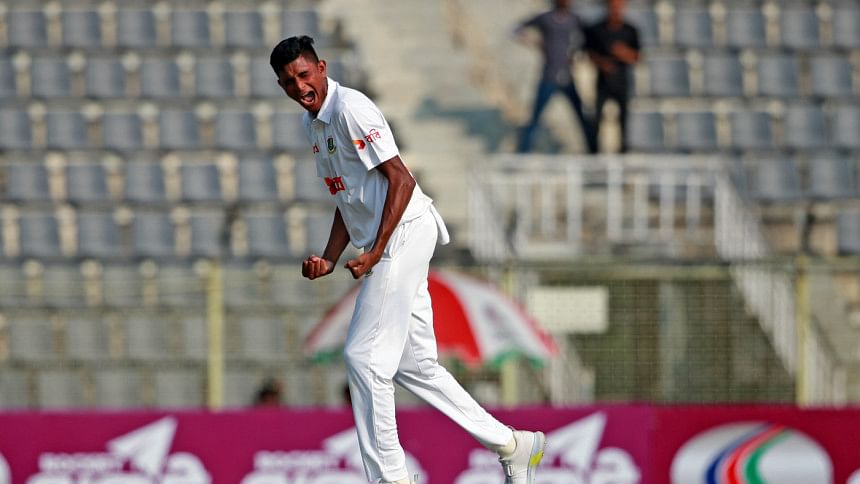Nahid Rana: A golden goose worth taking care of

One of Aesop's renowned fables, 'The goose that laid the golden egg', imparts a timeless lesson: too much greed can ruin one's fortune. It also highlights the value of patience -- a virtue the Bangladesh Cricket Board could embrace to nurture the immense potential of one of their brightest prospects, Nahid Rana.
The youngster on Monday treated the hopelessly optimistic Bangladesh fans, who tuned to watch the third day's play of the second Test against the West Indies in Jamaica, with a breathtaking bowling performance.
Despite the team's prospects looking quite dire, Bangladesh speedster Rana did not only spring life back into the Tigers but also saw the visitors assume the driver's seat.
Rana breathed fire and the heat was too much to handle for the West Indian batters, who hopped, swayed, took blows and swung the bat blind while trying to cope with his raw pace.
The reading on the speed gun rarely dropped below 140kph and often skirted around the 150-mark and his line and length were similarly unrelenting.
The pitch at the Sabina Park felt tailor-made for Rana, who from his 6.3 feet stature took full toll of the movement offered from the wicket and made life difficult for the host batters.
Seeing him tear through the opposition and claim a maiden five-wicket haul in Tests inevitably brought up one question, however.
Why oh why, was Rana not picked for the first Test?
One match in, one match out
In the series opener, Bangladesh went with the pace trio of Taskin Ahmed, Hasan Mahmud and Shoriful Islam, leaving Rana on the bench. No official or unofficial source said anything about the pacer being injured or unfit. Rana was simply not picked.
A brief look through Rana's five-match-old Test career shows that this was not a one-off occurrence.
Rana made his debut in March this year against Sri Lanka in Sylhet in the first of a two-Test series but was left out in the second match.
In August, he played both Tests against Pakistan in Rawalpindi. But in the away series against India and then the home series against South Africa, he played one match each.
This tendency of playing the pacer sporadically may seem like an error from the team management. But in retrospect, it has been a wise choice.
To say an express pacer like Rana is a rare commodity in Bangladesh cricket is a gross understatement. A pacer with such raw pace would be considered a special talent anywhere. But bowling this fast takes a toll on the human body.
Pacers are naturally more prone to injuries than cricketers of other specialties and hence need extra care. And for an express fast bowler like Rana, the need for care increases in folds as one misstep is enough to ruin a career.

The pitfall of greed
Bangladesh's track record of handling fast bowlers is not exactly great. In fact, it could be argued that the team management singlehandedly took years out of the career of the first true fast-bowling prodigy the country ever had.
Mashrafe Bin Mortaza, Bangladesh's most successful white-ball captain, was the country's first true pace bowling sensation too.
In November 2001, at 18 years of age, Mashrafe made his Test debut in Dhaka and almost immediately grabbed everyone's attention. In him, Bangladesh finally had a pacer who could bowl in excess of 140kph.
And the Tigers did not shy away from using his services, making him bowl over 60 overs in his first two Tests.
About a month later, he was in Hamilton, playing a Test against the Kiwis while carrying back pain. The team management knew about his pain, but still used him for 27 overs in the lone bowling innings for Bangladesh, more than anyone else in the attack.
It was reported by the media at the time that Mashrafe was in so much pain that he did not bowl at all in the net session before the second Test was expected to be rested.
But coach Trevor Chappell and captain Khaled Mashud could not resist the temptation of having a genuine pacer in the attack. Mashrafe played in the Wellington Test as well, while carrying the injury, trudged through 16 overs before leaving the field in pain.
It took Mashrafe more than a year to recover and return to the Test arena but his pace was never the same. He still remained an effective bowler and carved out a decent international career but never reached the height he might have.
Preserving the Golden Goose
Now, coming back to the question posed at the beginning, the Bangladesh team management, led by head coach Phil Simmons, surely knew Rana could be a lethal bowler in Caribbean conditions and improve Bangladesh's chances drastically.
Still, they chose to sit Rana out in the Antigua Test, which they lost by 201 runs, to manage his workload. Presumably, they sat him out for one Test each in the India and South Africa series for the same reason.
Simmons, who has also coached the West Indies team in two terms, knew that the wicket in Jamaica would suit Rana's style even more and chose to unleash him in the second Test.
"We knew it was coming at some stage. When you bowl 150kph, you are going to take wickets eventually. We've got to look after him. That's why he didn't play in the first Test match," said Bangladesh bowling coach Andre Adams after the day's play.
The ploy has worked wonderfully so far, as after winning the first Test quite easily, the hosts were almost lulled into a sense of security, which got shattered by Rana.
Now, some might feel that by not playing Rana in the first Test, Bangladesh missed a serious trick. But, the aforementioned fable of Aesop and Mashrafe's tragic career teaches us that it's better to be extra cautious with your golden goose as too much greed could leave one without any gold at all.

 For all latest news, follow The Daily Star's Google News channel.
For all latest news, follow The Daily Star's Google News channel. 








Comments